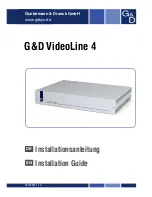
Introduction
AVT Prosilica GT Technical Manual
V2.0.8
9
Cleaning optics
Identifying debris
Debris on the image sensor or optical components appears as a darkened area
or smudge on a camera image. Do not confuse this with a pixel defect which
appears as a distinct point.
Locating debris
First determine whether the debris is on the sensor glass, IR filter (if used), or
lens. The farther away the debris is from the sensor, the blurrier the debris
appears on a camera image.
Stream a live image from the camera using a uniform target, such as a piece of
paper. To determine if the debris is on the camera lens, rotate the lens indepen-
dent of the camera. If the spot moves, the debris is on the lens. Otherwise, the
debris is on the IR filter (if used) or sensor glass.
Color cameras with IR filter
Prosilica GT color cameras are equipped with an IR filter. With no lens or lens
cap on a camera, the IR filter is exposed and debris can accumulate on it. This is
the most probable location for debris. It should not be necessary to remove the
IR filter for cleaning. Clean the outside of the IR filter glass using the tech-
niques explained in the next section. If it is determined that the debris is on the
inside surface of the filter glass, or the sensor glass, IR filter removal is neces-
sary.
Caution
Do not exceed environmental specifications.
See environmental specifications limits in the Specifications
section of this document. Special care must be taken to main-
tain a reasonable operating temperature. If the camera is oper-
ated in temperatures higher than the specified range, the
camera should be mounted on a heat sink.
For more information on camera body temperature:
http://www.alliedvisiontec.com/fileadmin/content/PDF/
Support/Application_Notes/AppNote_-
_Prosilica_GT_Body_Temperature.pdf
Caution
Do not touch any optics with fingers. Oil from fingers can
damage fragile optical coatings.










































